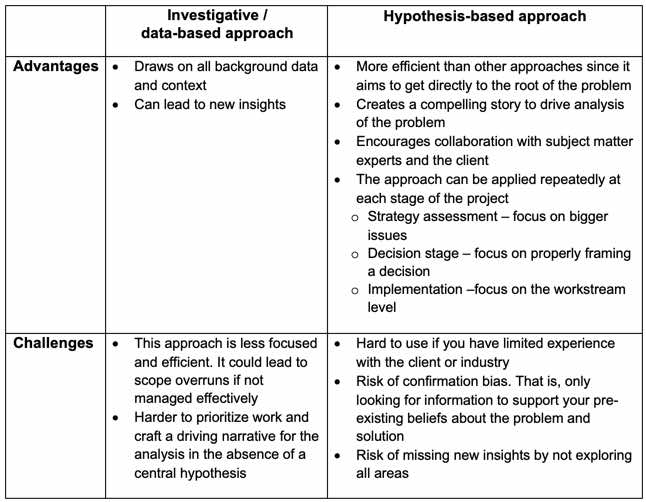There are generally two main approaches to solving problems in consulting, namely the:
- Investigative / data-based approach, and
- Hypothesis-based approach.
The investigative approach is appropriate when the opportunity is well-defined, repetitive, and standardized, or where the solution is clear from the beginning. Progress is made by employing technical and subject matter expertise to drive towards the solution. For example, implementing new IT software for a business unit.
The investigative approach generally involves:
- Collecting and analyzing data
- Understanding key issues
- Identifying and developing solutions
In contrast, the hypothesis-based approach to problem solving is appropriate where the opportunity is unstructured and unique and does not have an obvious solution. Progress is made by employing systematic problem-solving skills to validate an initial premise and circle in on the root cause of the issue before proposing possible solutions. For example, the enterprise may be facing a profitability decline and needs to conduct a strategic assessment.
The hypothesis-based approach generally involves:
- Using deep experience of the industry, organization, and issues
- Developing one or more initial hypotheses about the real problem and possible solutions
- Identifying data and analysis needed to prove or disprove the hypothesis
Investigative vs Hypothesis-based Approach
Here is a summary of the advantages and challenges of the investigative versus the hypothesis-based approach.
Clients pay consultants to give them valuable insights and do this quickly. As such, consultants tend to employ the hypothesis-based approach wherever they can. Since leading consulting firms typically have extensive industry experience, this helps consultants to focus on the most likely problem and solution areas. This ensures that all data gathering and analysis has a clear purpose and time is not wasted doing aimless work.
Hypothesis-based Problem-Solving Approach
The hypothesis-based problem solving (HBPS) approach is a framework used in strategy consulting to develop insights and recommendations based on a structured, evidence-based process.
The HBPS process has five key steps.
1. Define the problem
Defining the problem is critical to the success of the HBPS approach. This involves understanding the broader context by engaging with the client to gain an understanding of the challenges they are facing. This might also involve conducting interviews with key stakeholders, reviewing relevant documents and data, and conducting market research to understand the situation.
Once the context is adequately understood, the consultant will need to define the scope and objectives of the engagement. This might involve drafting a written proposal that outlines the scope of the engagement, key deliverables, and the timeline for completion.
2. Define drivers and generate/refine hypotheses
Defining drivers involves identifying factors that contribute to the situation at hand. For example, if a company is experiencing declining sales, the drivers might include changes in consumer behaviour, increased competition, or a decline in product quality. To identify potential drivers, consultants will typically conduct research, such as reviewing financial data, market research reports, or conducting surveys, focus groups, or interviews with key stakeholders.
Once potential drivers have been identified, consultants can then generate hypotheses about the impact of each driver on the problem. For example, “Increased competition is causing a decline in market share” or “Changes in consumer preferences are reducing demand for the client’s product”.
3. Determine information needs
Identifying the required data sources requires reviewing the hypotheses and identifying the types of data required to test them. This might include financial data, market research, or customer feedback.
Consultants will also need to work with the client to develop a plan for collecting and analyzing the data. In developing this plan, consultants will need to ensure that the data to be collected is aligned with the scope and objectives of the engagement.
4. Gather and analyze the data
Collecting data from relevant sources might involve conducting primary research, such as surveys, interviews, or focus groups, or conducting secondary research, such as reviewing industry reports or analyzing financial data. In collecting the required data, consultants will need to ensure that the data is relevant, accurate, and comprehensive.
Analyzing the data to test the hypotheses might then involve conducting various forms of statistical and data analysis.
5. Draw conclusions and develop recommendations
Drawing conclusions requires evaluating the results of the data analysis. This involves identifying patterns, trends, or insights that emerge from the data.
Developing recommendations from the insights generated will require synthesizing the findings into actionable recommendations. These recommendations might include specific projects or initiatives that the client should undertake to address the problem faced, or might involve broader strategic recommendations related to the client’s business or industry. The consultants should ensure that recommendations are actionable, measurable, and realistic, and that they can be implemented within a particular timeframe and budget.
The bottom line
The two main approaches to problem-solving in consulting are the investigative/data-based approach and the hypothesis-based approach. The former can be used where the problem is well-defined, while the latter can be used when the problem is novel.
The hypothesis-based approach is generally more efficient and aims to get directly to the root of the problem. Clients pay consultants to give them valuable insights quickly, which is why consultants tend to employ the hypothesis-based approach.
The HBPS approach involves five key steps: defining the problem, generating hypotheses, determining information needs, gathering and analyzing the data, and developing recommendations based on the insights generated.
In the next article, we will explore the five key steps of the HBPS approach in greater detail.
Jason Oh is a Senior Associate at Strategy&. Previously, he was part of the Global Wealth & Asset Management Strategy team of a large financial institution and served EY and Novantas in their strategy consulting business with industry focus in the financial services sector.
Image: Unsplash


One reply on “Solving Problems with the Hypothesis-based Approach”
[…] we saw in the previous article, the HBPS process has five key […]